engine TOYOTA BZ4X 2022 Owners Manual (in English)
[x] Cancel search | Manufacturer: TOYOTA, Model Year: 2022, Model line: BZ4X, Model: TOYOTA BZ4X 2022Pages: 674, PDF Size: 120.02 MB
Page 9 of 674
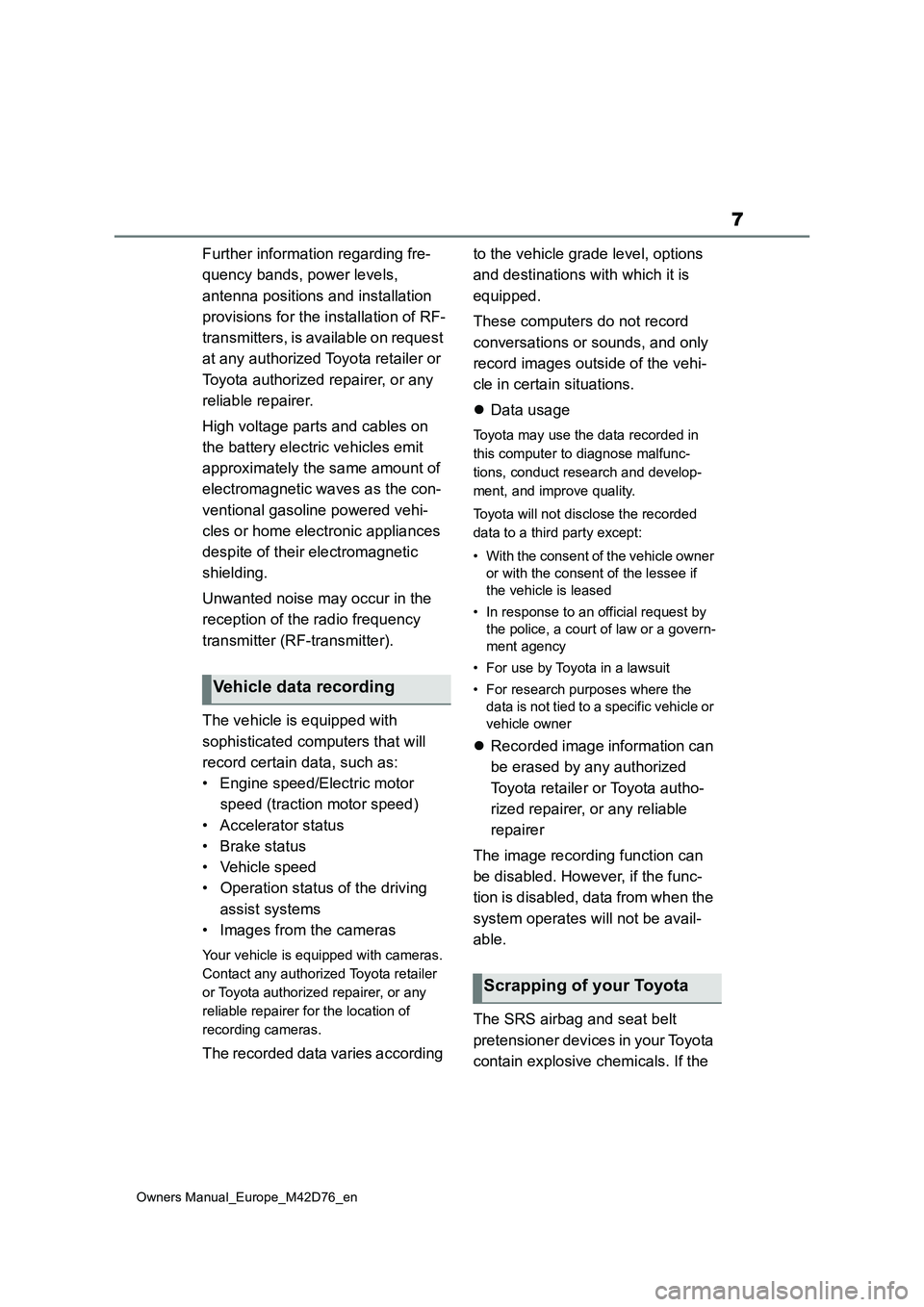
7
Owners Manual_Europe_M42D76_en
Further information regarding fre-
quency bands, power levels,
antenna positions and installation
provisions for the installation of RF-
transmitters, is available on request
at any authorized Toyota retailer or
Toyota authorized repairer, or any
reliable repairer.
High voltage parts and cables on
the battery electric vehicles emit
approximately the same amount of
electromagnetic waves as the con-
ventional gasoline powered vehi-
cles or home electronic appliances
despite of their electromagnetic
shielding.
Unwanted noise may occur in the
reception of the radio frequency
transmitter (RF-transmitter).
The vehicle is equipped with
sophisticated computers that will
record certain data, such as:
• Engine speed/Electric motor
speed (traction motor speed)
• Accelerator status
• Brake status
• Vehicle speed
• Operation status of the driving
assist systems
• Images from the cameras
Your vehicle is equipped with cameras.
Contact any authorized Toyota retailer
or Toyota authorized repairer, or any
reliable repairer for the location of
recording cameras.
The recorded data varies according
to the vehicle grade level, options
and destinations with which it is
equipped.
These computers do not record
conversations or sounds, and only
record images outside of the vehi-
cle in certain situations.
Data usage
Toyota may use the data recorded in
this computer to diagnose malfunc-
tions, conduct research and develop-
ment, and improve quality.
Toyota will not disclose the recorded
data to a third party except:
• With the consent of the vehicle owner
or with the consent of the lessee if
the vehicle is leased
• In response to an official request by
the police, a court of law or a govern-
ment agency
• For use by Toyota in a lawsuit
• For research purposes where the
data is not tied to a specific vehicle or
vehicle owner
Recorded image information can
be erased by any authorized
Toyota retailer or Toyota autho-
rized repairer, or any reliable
repairer
The image recording function can
be disabled. However, if the func-
tion is disabled, data from when the
system operates will not be avail-
able.
The SRS airbag and seat belt
pretensioner devices in your Toyota
contain explosive chemicals. If the
Vehicle data recording
Scrapping of your Toyota
Page 86 of 674
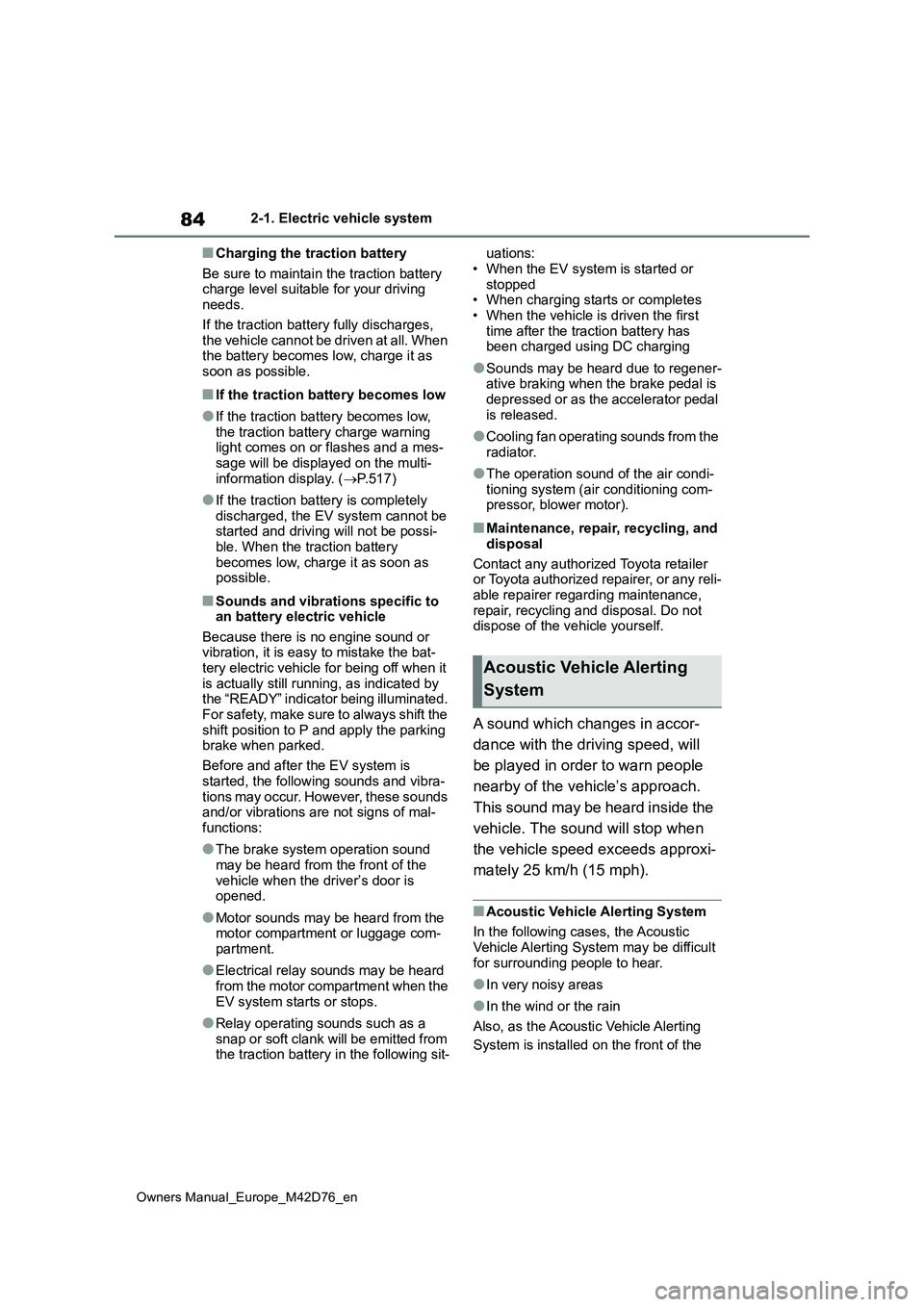
84
Owners Manual_Europe_M42D76_en
2-1. Electric vehicle system
■Charging the traction battery
Be sure to maintain the traction battery charge level suitable for your driving needs.
If the traction battery fully discharges, the vehicle cannot be driven at all. When the battery becomes low, charge it as
soon as possible.
■If the traction battery becomes low
●If the traction battery becomes low,
the traction battery charge warning light comes on or flashes and a mes-sage will be displayed on the multi-
information display. ( P.517)
●If the traction battery is completely
discharged, the EV system cannot be started and driving will not be possi-ble. When the traction battery
becomes low, charge it as soon as possible.
■Sounds and vibrations specific to an battery electric vehicle
Because there is no engine sound or vibration, it is easy to mistake the bat-tery electric vehicle for being off when it
is actually still running, as indicated by the “READY” indicator being illuminated. For safety, make sure to always shift the
shift position to P and apply the parking brake when parked.
Before and after the EV system is
started, the following sounds and vibra- tions may occur. However, these sounds and/or vibrations are not signs of mal-
functions:
●The brake system operation sound
may be heard from the front of the vehicle when the driver’s door is opened.
●Motor sounds may be heard from the motor compartment or luggage com-
partment.
●Electrical relay sounds may be heard
from the motor compartment when the EV system starts or stops.
●Relay operating sounds such as a snap or soft clank will be emitted from the traction battery in the following sit-
uations:
• When the EV system is started or stopped• When charging starts or completes
• When the vehicle is driven the first time after the traction battery has been charged using DC charging
●Sounds may be heard due to regener-ative braking when the brake pedal is
depressed or as the accelerator pedal is released.
●Cooling fan operating sounds from the radiator.
●The operation sound of the air condi-tioning system (air conditioning com-pressor, blower motor).
■Maintenance, repair, recycling, and
disposal
Contact any authorized Toyota retailer or Toyota authorized repairer, or any reli-
able repairer regarding maintenance, repair, recycling and disposal. Do not dispose of the vehicle yourself.
A sound which changes in accor-
dance with the driving speed, will
be played in order to warn people
nearby of the vehicle’s approach.
This sound may be heard inside the
vehicle. The sound will stop when
the vehicle speed exceeds approxi-
mately 25 km/h (15 mph).
■Acoustic Vehicle Alerting System
In the following cases, the Acoustic Vehicle Alerting System may be difficult
for surrounding people to hear.
●In very noisy areas
●In the wind or the rain
Also, as the Acoustic Vehicle Alerting
System is installed on the front of the
Acoustic Vehicle Alerting
System
Page 91 of 674
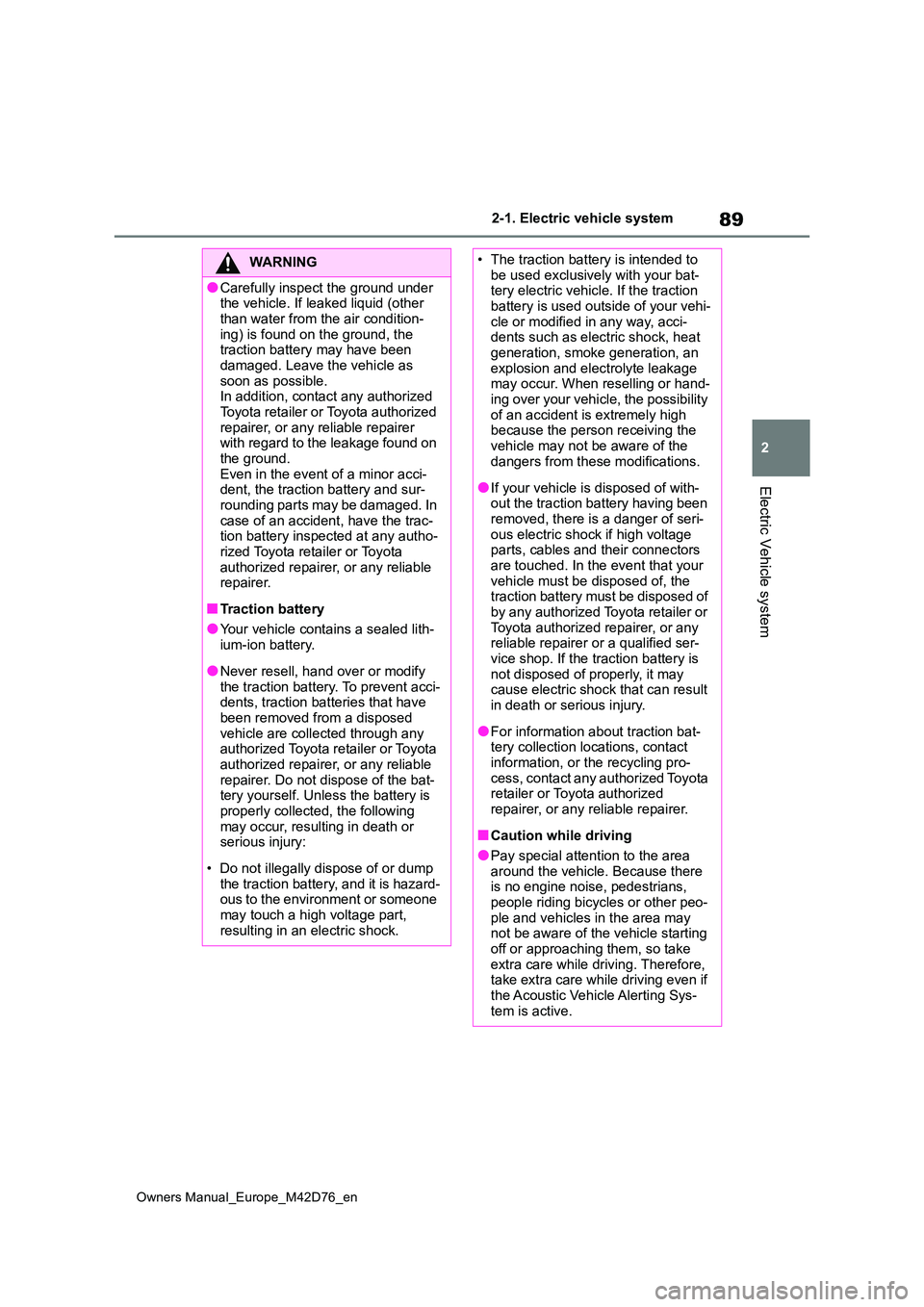
89
2
Owners Manual_Europe_M42D76_en
2-1. Electric vehicle system
Electric Vehicle system
WARNING
●Carefully inspect the ground under the vehicle. If leaked liquid (other
than water from the air condition- ing) is found on the ground, the traction battery may have been
damaged. Leave the vehicle as soon as possible. In addition, contact any authorized
Toyota retailer or Toyota authorized repairer, or any reliable repairer with regard to the leakage found on
the ground. Even in the event of a minor acci-dent, the traction battery and sur-
rounding parts may be damaged. In case of an accident, have the trac-tion battery inspected at any autho-
rized Toyota retailer or Toyota authorized repairer, or any reliable repairer.
■Traction battery
●Your vehicle contains a sealed lith-
ium-ion battery.
●Never resell, hand over or modify
the traction battery. To prevent acci- dents, traction batteries that have been removed from a disposed
vehicle are collected through any authorized Toyota retailer or Toyota authorized repairer, or any reliable
repairer. Do not dispose of the bat- tery yourself. Unless the battery is properly collected, the following
may occur, resulting in death or serious injury:
• Do not illegally dispose of or dump the traction battery, and it is hazard-ous to the environment or someone
may touch a high voltage part, resulting in an electric shock.
• The traction battery is intended to be used exclusively with your bat-tery electric vehicle. If the traction
battery is used outside of your vehi- cle or modified in any way, acci-dents such as electric shock, heat
generation, smoke generation, an explosion and electrolyte leakage may occur. When reselling or hand-
ing over your vehicle, the possibility of an accident is extremely high because the person receiving the
vehicle may not be aware of the dangers from these modifications.
●If your vehicle is disposed of with-out the traction battery having been removed, there is a danger of seri-
ous electric shock if high voltage parts, cables and their connectors are touched. In the event that your
vehicle must be disposed of, the traction battery must be disposed of by any authorized Toyota retailer or
Toyota authorized repairer, or any reliable repairer or a qualified ser-vice shop. If the traction battery is
not disposed of properly, it may cause electric shock that can result in death or serious injury.
●For information about traction bat-tery collection locations, contact
information, or the recycling pro- cess, contact any authorized Toyota retailer or Toyota authorized
repairer, or any reliable repairer.
■Caution while driving
●Pay special attention to the area around the vehicle. Because there is no engine noise, pedestrians,
people riding bicycles or other peo- ple and vehicles in the area may not be aware of the vehicle starting
off or approaching them, so take extra care while driving. Therefore, take extra care while driving even if
the Acoustic Vehicle Alerting Sys- tem is active.
Page 179 of 674

177
3
Owners Manual_Europe_M42D76_en
3-1. Instrument cluster
Vehicle status information and indicators
erence only.
Current power consumption
Displays instantaneous current power
consumption.
Trip Average/Total Average
To reset the average power consump-
tion display, press and hold the
meter control switch.
The average power consumption
display can be changed in .
( P.561)
Tr i p Ave ra ge
Displays the average power consump-
tion since EV system start.
Total Average
Displays the average power consump-
tion since the vehicle was recharged.
■Power consumption
It is a numerical value that represents
the power consumption rate and corre- sponds to the fuel consumption rate of gasoline engine vehicles. In this car, the
number of kilometers traveled (km / kWh) per kilowatt hour of electricity (1 kWh) is displayed on each screen as
“electricity cost”.
■Driving support system infor-
mation
Select to display the operational
status of the following systems:
PCS (Pre-Collision System)
( P.283)
LDA (Lane Departure Alert)
( P.299)
LTA (Lane Tracing Assist)
( P.294)
Cruise control (P.316)
Dynamic radar cruise control
( P.307)
RSA (Road Sign Assist)
( P.304)
■Navigation system-linked dis-
play (if equipped)
Select to display the following navi-
gation system-linked information:
Route guidance to destination
Compass display (heading-up
display)
Select to enable selection of an
audio source or track on the meter
using the meter control switches.
This menu icon can be set to be dis-
played/not displayed in .
Driving support system
information display
Audio system-linked display
Page 232 of 674

230
Owners Manual_Europe_M42D76_en
5-1. Before driving
●Drive carefully when it starts to rain,
because the road surface will be especially slippery.
●Refrain from high speeds when driv-ing on an expressway in the rain, because there may be a layer of water
between the tires and the road sur- face, preventing the steering and brakes from operating properly.
■Restraining the EV system output
(Brake Override System)
●When the accelerator and brake ped-
als are depressed at the same time, the EV system output may be restrained.
●A warning message is displayed on the multi-information display while the
system is operating.
■Breaking in your new Toyota
To extend the life of the vehicle, observ- ing the following precautions is recom-
mended:
●For the first 300 km (186 miles):
Avoid sudden stops.
●For the first 800 km (500 miles):
Do not tow a trailer.
●For the first 1000 km (621 miles):
• Do not drive at extremely high speeds.• Avoid sudden acceleration.
• Do not drive at a constant speed for extended periods.
WARNING
Observe the following precautions.
Failure to do so may result in death or serious injury.
■When starting the vehicle
Always keep your foot on the brake pedal while stopped with the
“READY” indicator is illuminated. This prevents the vehicle from creeping.
■When driving the vehicle
●Do not drive if you are unfamiliar with the location of the brake and
accelerator pedals to avoid depressing the wrong pedal.
• Accidentally depressing the accel- erator pedal instead of the brake pedal will result in sudden accelera-
tion that may lead to an accident.
• When backing up, you may twist
your body around, leading to diffi- culty in operating the pedals. Make sure to operate the pedals properly.
• Make sure to keep a correct driving posture even when moving the
vehicle only slightly. This allows you to depress the brake and accelera-tor pedals properly.
• Depress the brake pedal using your right foot. Depressing the brake
pedal using your left foot may delay response in an emergency, result-ing in an accident.
●The driver should pay extra atten-tion to pedestrians. As there is no
engine noise, the pedestrians may misjudge the vehicle’s movement. Even though the vehicle is
equipped with the Acoustic Vehicle Alerting System, drive with care as pedestrians in the vicinity may still
not notice the vehicle if the sur- rounding area is noisy.
●During normal driving, do not turn off the EV system. Turning the EV system off while driving will not
cause loss of steering or braking control, however, power assist to the steering will be lost. This will
make it more difficult to steer smoothly, so you should pull over and stop the vehicle as soon as it is
safe to do so. In the event of an emergency, such as if it becomes impossible to stop the vehicle in the
normal way: P. 5 0 6
Page 337 of 674
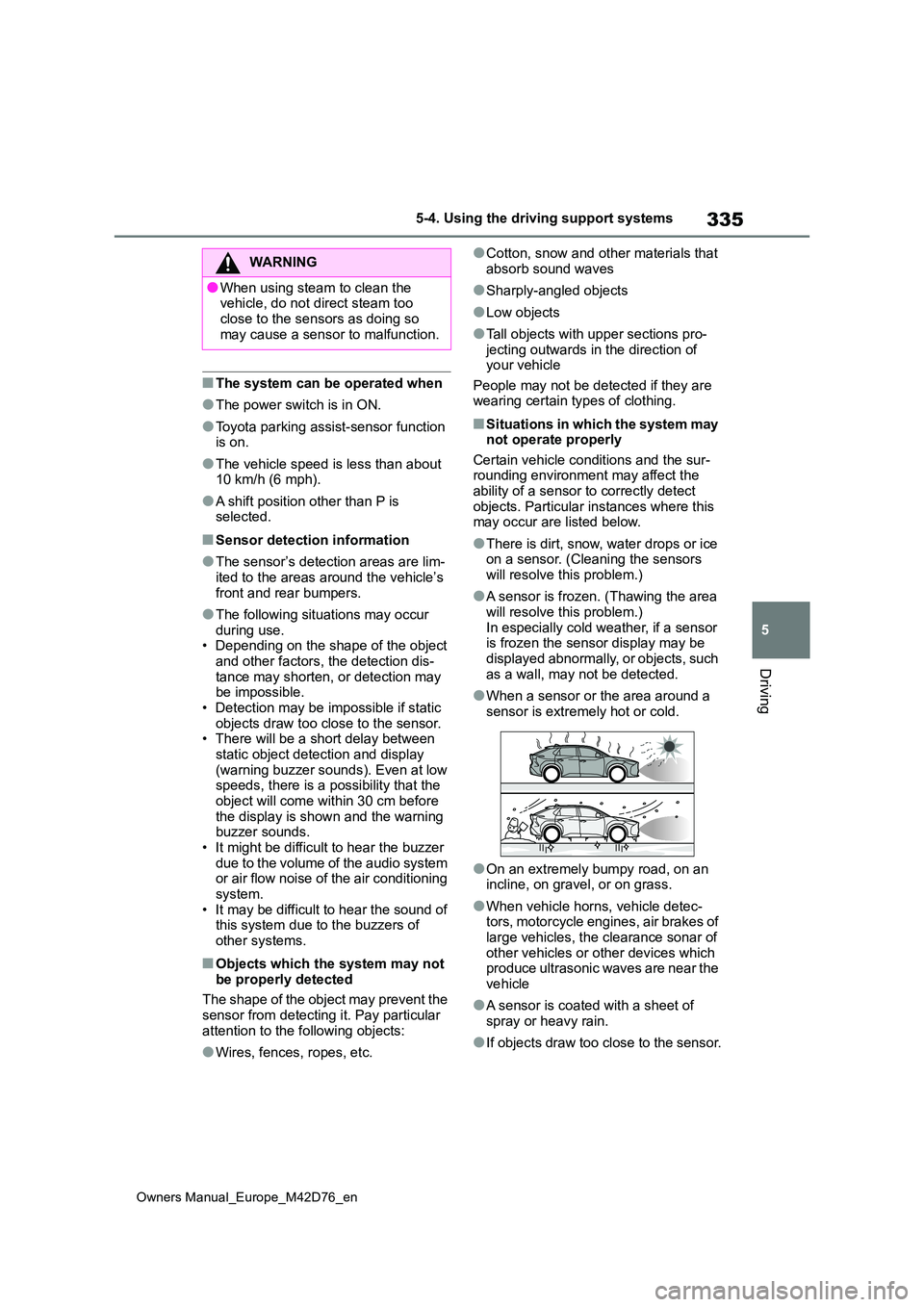
335
5
Owners Manual_Europe_M42D76_en
5-4. Using the driving support systems
Driving
■The system can be operated when
●The power switch is in ON.
●Toyota parking assist-sensor function is on.
●The vehicle speed is less than about 10 km/h (6 mph).
●A shift position other than P is selected.
■Sensor detection information
●The sensor’s detection areas are lim-ited to the areas around the vehicle’s
front and rear bumpers.
●The following situations may occur
during use. • Depending on the shape of the object and other factors, the detection dis-
tance may shorten, or detection may be impossible.• Detection may be impossible if static
objects draw too close to the sensor. • There will be a short delay between static object detection and display
(warning buzzer sounds). Even at low speeds, there is a possibility that the object will come within 30 cm before
the display is shown and the warning buzzer sounds.• It might be difficult to hear the buzzer
due to the volume of the audio system or air flow noise of the air conditioning system.
• It may be difficult to hear the sound of this system due to the buzzers of other systems.
■Objects which the system may not
be properly detected
The shape of the object may prevent the sensor from detecting it. Pay particular
attention to the following objects:
●Wires, fences, ropes, etc.
●Cotton, snow and other materials that
absorb sound waves
●Sharply-angled objects
●Low objects
●Tall objects with upper sections pro- jecting outwards in the direction of your vehicle
People may not be detected if they are wearing certain types of clothing.
■Situations in which the system may not operate properly
Certain vehicle conditions and the sur- rounding environment may affect the ability of a sensor to correctly detect
objects. Particular instances where this may occur are listed below.
●There is dirt, snow, water drops or ice on a sensor. (Cleaning the sensors will resolve this problem.)
●A sensor is frozen. (Thawing the area will resolve this problem.)
In especially cold weather, if a sensor is frozen the sensor display may be displayed abnormally, or objects, such
as a wall, may not be detected.
●When a sensor or the area around a
sensor is extremely hot or cold.
●On an extremely bumpy road, on an incline, on gravel, or on grass.
●When vehicle horns, vehicle detec-tors, motorcycle engines, air brakes of large vehicles, the clearance sonar of
other vehicles or other devices which produce ultrasonic waves are near the vehicle
●A sensor is coated with a sheet of spray or heavy rain.
●If objects draw too close to the sensor.
WARNING
●When using steam to clean the vehicle, do not direct steam too
close to the sensors as doing so may cause a sensor to malfunction.
Page 338 of 674
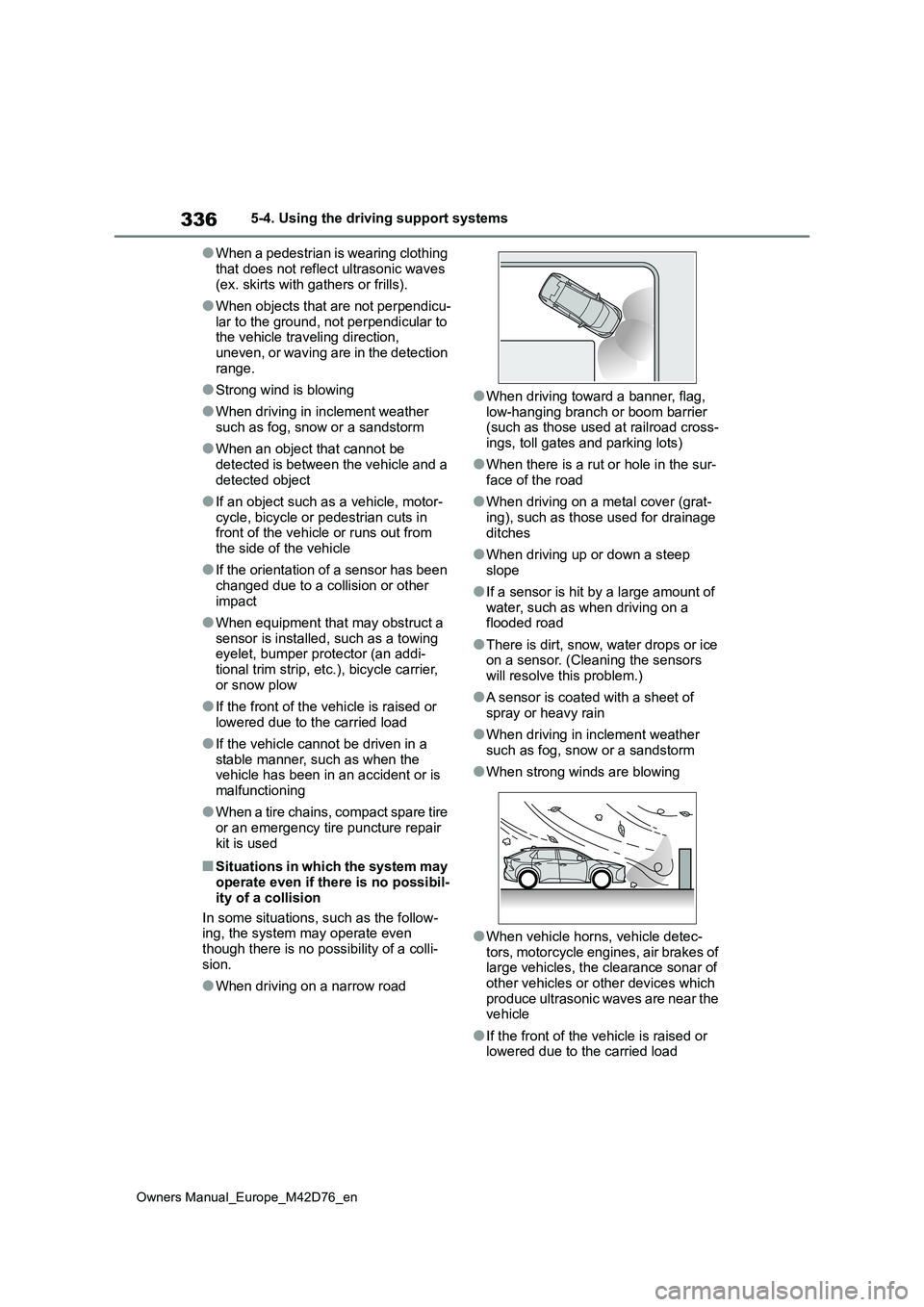
336
Owners Manual_Europe_M42D76_en
5-4. Using the driving support systems
●When a pedestrian is wearing clothing
that does not reflect ultrasonic waves (ex. skirts with gathers or frills).
●When objects that are not perpendicu-lar to the ground, not perpendicular to the vehicle traveling direction,
uneven, or waving are in the detection range.
●Strong wind is blowing
●When driving in inclement weather
such as fog, snow or a sandstorm
●When an object that cannot be
detected is between the vehicle and a detected object
●If an object such as a vehicle, motor-cycle, bicycle or pedestrian cuts in front of the vehicle or runs out from
the side of the vehicle
●If the orientation of a sensor has been
changed due to a collision or other impact
●When equipment that may obstruct a sensor is installed, such as a towing eyelet, bumper protector (an addi-
tional trim strip, etc.), bicycle carrier, or snow plow
●If the front of the vehicle is raised or lowered due to the carried load
●If the vehicle cannot be driven in a stable manner, such as when the vehicle has been in an accident or is
malfunctioning
●When a tire chains, compact spare tire
or an emergency tire puncture repair kit is used
■Situations in which the system may operate even if there is no possibil-
ity of a collision
In some situations, such as the follow- ing, the system may operate even
though there is no possibility of a colli- sion.
●When driving on a narrow road
●When driving toward a banner, flag,
low-hanging branch or boom barrier (such as those used at railroad cross-ings, toll gates and parking lots)
●When there is a rut or hole in the sur-face of the road
●When driving on a metal cover (grat-ing), such as those used for drainage
ditches
●When driving up or down a steep
slope
●If a sensor is hit by a large amount of
water, such as when driving on a flooded road
●There is dirt, snow, water drops or ice on a sensor. (Cleaning the sensors will resolve this problem.)
●A sensor is coated with a sheet of spray or heavy rain
●When driving in inclement weather such as fog, snow or a sandstorm
●When strong winds are blowing
●When vehicle horns, vehicle detec-tors, motorcycle engines, air brakes of large vehicles, the clearance sonar of
other vehicles or other devices which produce ultrasonic waves are near the vehicle
●If the front of the vehicle is raised or lowered due to the carried load
Page 548 of 674
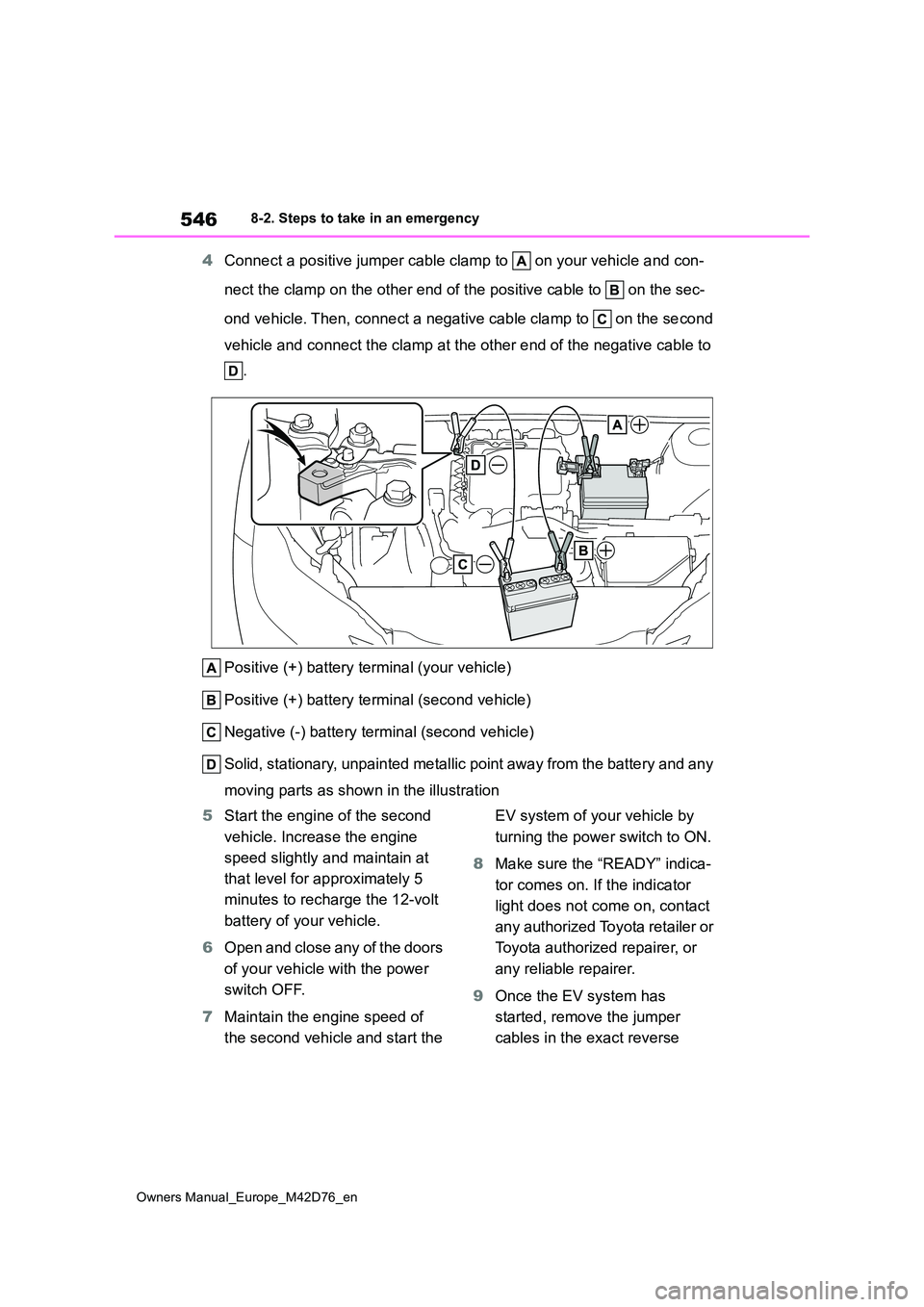
546
Owners Manual_Europe_M42D76_en
8-2. Steps to take in an emergency
4Connect a positive jumper cable clamp to on your vehicle and con-
nect the clamp on the other end of the positive cable to on th e sec-
ond vehicle. Then, connect a negative cable clamp to on the se cond
vehicle and connect the clamp at the other end of the negative cable to
.
Positive (+) battery terminal (your vehicle)
Positive (+) battery terminal (second vehicle)
Negative (-) battery terminal (second vehicle)
Solid, stationary, unpainted metallic point away from the batte ry and any
moving parts as shown in the illustration
5 Start the engine of the second
vehicle. Increase the engine
speed slightly and maintain at
that level for approximately 5
minutes to recharge the 12-volt
battery of your vehicle.
6 Open and close any of the doors
of your vehicle with the power
switch OFF.
7 Maintain the engine speed of
the second vehicle and start the
EV system of your vehicle by
turning the power switch to ON.
8 Make sure the “READY” indica-
tor comes on. If the indicator
light does not come on, contact
any authorized Toyota retailer or
Toyota authorized repairer, or
any reliable repairer.
9 Once the EV system has
started, remove the jumper
cables in the exact reverse